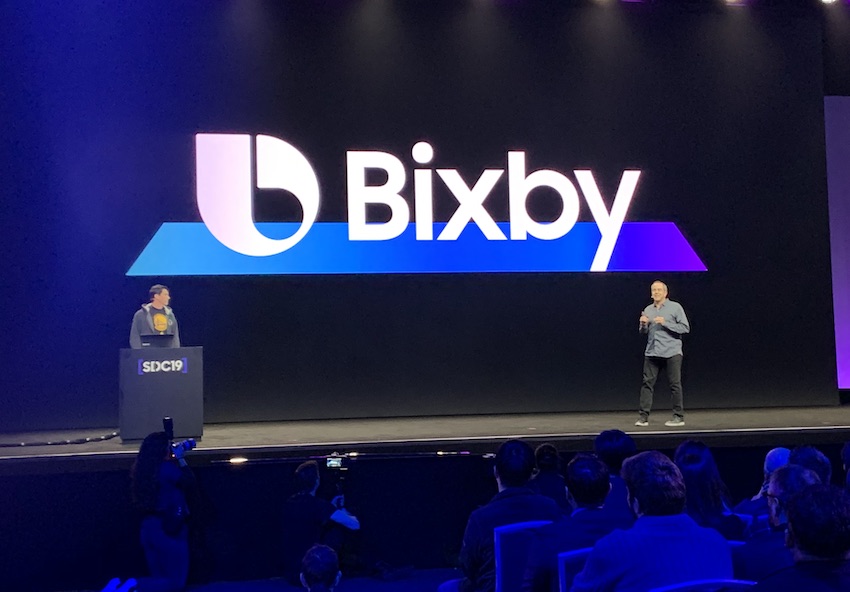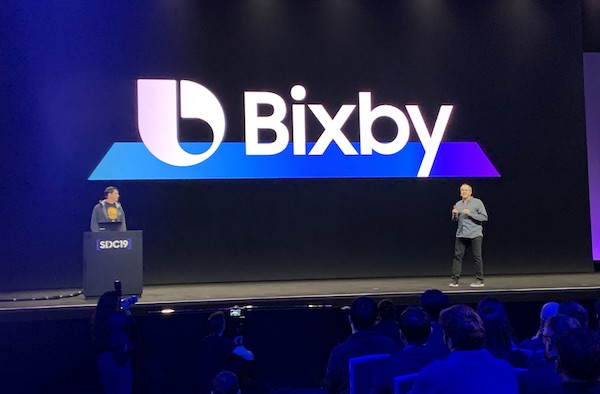Samsung Bixby Now on 160 Million Devices and New Features Launched for Personalization, Ease of Access to Third-Party Capsules, and Templates to Streamline Development

Adam Cheyer and Larry Heck of Samsung / Viv Labs at SDC19
During the Samsung Developer Conference this morning, executive vice president of R&D Eui-Suk Chung began the Bixby discussion by saying there are now more than 160 million Samsung devices that can access the voice assistant. The Bixby developer community has doubled in the last year, he added.
Chung was followed by Larry Heck and Adam Cheyer, the top executives overseeing Bixby and Viv Labs for Samsung. They announced new features for personalization, ease of use, and templates to streamline Bixby capsule (i.e. voice app) development.
Bixby Pushed Forward on Voice Assistant Personalization
The new Bixby personalization features were first demonstrated at the Voice 19 conference in July and showed how the services can streamline and enhance user experience. Most current voice assistant services, whether first-party offered by the voice platforms or provided by third-party developers are generic. They don’t remember preferences or past usage patterns. Only a few services offer some personalization through account-linking. Samsung is adjusting its platform to enable users to select favorite capsules and services, personalizing the experience.
Cheyer demonstrated how a request to Bixby for a car service directed him to activate capsules from Lyft or Uber. He activated both and then asked Bixby for a ride. Bixby responded by asking whether he wanted to use Lyft or Uber. When Cheyer responded, “Lyft,” Bixby asked if he would like to make that the default. Selecting it as the default means that future rides would automatically be booked with Lyft even if he doesn’t specify that ride service. He then demonstrated that he could still request a ride from Uber, but needed to specify that he wanted Uber in the request. That is similar to the explicit requests most voice assistants require at the moment.
Voice assistants are moving toward automatically identifying user preferences. We are seeing the seeds of that in Siri Shortcut recommendations and Alexa’s forthcoming suggested routines feature. Samsung is including personalization by having Bixby ask users to state their preferences during conversations about capsules. That makes it easier for users to access third-party capsules as if they are native, first-party experiences.
Natural Language Categories Make it Easier for Third-Party Discovery
The core element enabling Bixby’s personalization and easy access to third-party capsules is called Natural Langauge Categories. NLC, which developers can start using as of today, allow users to ask for a topic such as the request for a ride example above. Bixby then recommends capsules that can fulfill the need. In other words, Bixby is proactively enabling third-party voice app discovery. This is a high priority request for developers on all consumer voice assistant platforms. It differs from Alexa Conversations, which stitches together multiple Alexa skills as if they are part of a first-party experience. Samsung’s design puts specific third-party capsules front and center.
In addition, a Samsung engineer mentioned to Voicebot that Natural Language Categories enable a third-party capsule to act as if it is a first-party capsule. Developers will immediately understand the benefit of this. Voice assistant users sometimes or often forget the name of a voice app and therefore miss the opportunity to invoke that service. Without an explicit request for a voice app by name, a voice assistant may take care of the request using its own services or even recommend another third-party service. That won’t hapen with the Natural Lange Categories. The company believes this offers third-party developers equal footing with anything built in-house by Samsung.
Samsung said there are 14 natural language categories today and more are expected soon. Some examples already available include news, radio, cooking and recipes, home services, translators, and local businesses. For these categories, users can make a request and third-party capsules will be part of the response if they fit the intent.
New Bixby Templates Streamline Capsule Development
The new Bixby Templates is designed to streamline capsule development.
“We wanted to give you an easier way to get up and running,” said Larry Heck, Viv Labs CEO and Samsung senior vice president. Adam Cheyer, co-founder of Viv Labs and vice president of R&D at Samsung commented, “With Bixby Templates you no longer need to develop a capsule from scratch. Many of those templates are really quite simple.”
Bixby Templates will speed up development by software engineers. Samsung representatives said they are even simple enough that designers without software engineering expertise can use them to create capsules. The demonstration by Cheyer suggests that there is still some development knowledge required to use these templates. They are not as simple as Alexa Skill Blueprints for non-developers, but are closer to Google Action templates, although less complex than building in Dialogflow.
Cheyer also demonstrated that the templates enable developers to “build a capsule from any table that contains data.” The demonstration showed an Excel file with data on basketball teams and their game schedules. By uploading the spreadsheet into the Bixby development environment, the AI automatically creates a dataset to fulfill user requests. The developer just needs to follow that step by defining utterances and labeling the language in the speech so Bixby can automatically create an intent model.
Heck added, “In just a few seconds, the template has created a complete Bixby capsule using the data. You won’t find this in any other assistants. Notice that Bixby has created all of the code automatically. You can now create a capsule just by finding an interesting data source and telling [Bixby] what users may ask without writing any code.”
Rapid Feature Expansion but Will There Be Third-Party Content
Bixby is attempting to catch up with Alexa and Google Assistant from a feature standpoint while also introducing a new approach to voice assistant development and user personalization. Samsung’s voice assistant may have come to market after its biggest competitors, but seems to be closing the feature gap rapidly, especially given that the New Bixby debuted only a year ago. However, the bigger challenge for Bixby may be to accumulate enough third-party content to make users feel the experience is comparable to rival voice assistants, including the one on the same smartphones where Bixby is featured.
Follow @bretkinsella Follow @voicebotai
Samsung Bixby DevJam Contest will Award $125,000 in Prize Money
Adam Cheyer of Samsung and Viv Labs Talks 25 Years of Voice Assistants – Voicebot Podcast Ep 109









